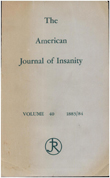Clinical assessment versus research methods in the assessment of suicidal behavior
Abstract
OBJECTIVE: This study examined how accurately routine inpatient clinical assessments documented a history of overt suicidal behavior in inpatients with a diagnosis of major depressive episode. Secondary questions involved the exploration of possible factors influencing the quality of routine clinical documentation of suicidal behavior, such as lethality of attempts, axis II comorbidity, and presence of recent suicidal behavior. METHOD: Hospital records for 50 patients, known to have a history of suicidal behavior on the basis of research ratings, were reviewed to assess reporting of the number of lifetime suicide attempts, suicidal ideation and planning behavior, most medically lethal suicide attempt, and family history of suicidal behavior. These measures of suicidal behavior were compared with a comprehensive research assessment, completed concurrently and independently. RESULTS: At admission clinicians failed to document a history of suicidal behavior in 12 of 50 patients identified by research assessment as depressed and as having attempted suicide. Fewer total suicide attempts were clinically reported than in research data. Documentation of suicidal behavior was least accurate in the physician discharge summary and was most accurate on hospital intake assessment, which employed a semistructured format for recording clinical information including suicidal behavior. CONCLUSIONS: A significant degree of past suicidal behavior is not recorded during routine clinical assessment, and the use of semistructured screening instruments may improve documentation and detection of lifetime suicidal behavior. The physician discharge summary must accurately document suicidal behavior, since it best identified a high-risk population for out-patient clinicians responsible for follow-up.
Access content
To read the fulltext, please use one of the options below to sign in or purchase access.- Personal login
- Institutional Login
- Sign in via OpenAthens
- Register for access
-
Please login/register if you wish to pair your device and check access availability.
Not a subscriber?
PsychiatryOnline subscription options offer access to the DSM-5 library, books, journals, CME, and patient resources. This all-in-one virtual library provides psychiatrists and mental health professionals with key resources for diagnosis, treatment, research, and professional development.
Need more help? PsychiatryOnline Customer Service may be reached by emailing [email protected] or by calling 800-368-5777 (in the U.S.) or 703-907-7322 (outside the U.S.).



